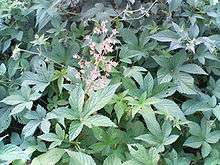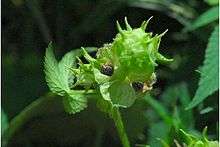Humulus japonicus
| Humulus japonicus | |
|---|---|
.png) | |
| Scientific classification | |
| Kingdom: | Plantae |
| Clade: | Angiosperms |
| Clade: | Eudicots |
| Clade: | Rosids |
| Order: | Rosales |
| Family: | Cannabaceae |
| Genus: | Humulus |
| Species: | H. japonicus |
| Binomial name | |
| Humulus japonicus | |
Humulus japonicus, known as wild hop[1] or Japanese hop,[2] synonym H. scandens, is an ornamental plant in the Cannabaceae family. Originally found in temperate parts of Asia (China, Japan, Korea, Taiwan and Russia) and the tropical environment of Vietnam, it was imported to North America in the 1800s for use in an Asian tonic and as an ornamental plant.[3] Since its arrival in North America, it has spread widely. It can be found throughout the Northeastern U.S. and eastern Canada. It is considered an invasive species in North America.[4] The composition and chemistry of its oils differ from those of its relative the common hop, Humulus lupulus. As a result, the Japanese hop is not used in the production of beer.[3]
This species is a host plant for the butterfly Polygonia c-aureum, the Asian comma.
Description


Well-developed leaves with 5-9 lobes; abaxial surfaces of leaves pubescent, but not densely so; infructescence rarely longer than 2 cm, with bracts and bracteoles less than 1 cm long, and notable spinulose-ciliate[5] Inflorescences: staminate inflorescences erect, 15–25 cm, flower anthers without glands; pistillate inflorescences spikes, conelike, ovoid; bracteole ovate-orbiculate, 7–10 mm, pilose, margins densely ciliate-hairy. Infructescences pendulous, green, conelike, ovoid to oblong, (1-)1.5-3(-4) cm; bracteoles without yellow glands.[6]
Dispersal
Seeds germinate in early spring, but plants may continue to emerge if conditions are favorable. Seeds can be dispersed by number of agents including humans, animals, machines, and flood waters.[3]
Distribution and habitat
Humulus japonicus originates in temperate regions of Asia and the Tropics of Vietnam, but has become an invasive species in North America after the plant was imported in the 1800s. The plant has been immensely successful in North America. It has an enormous range in North America can be found throughout eastern Canada and the eastern half of the United States. In the United States Humulus japonicus has a lateral range from North Dakota all the way to Maine and a vertical range from Minnesota to Georgia.[7] Japanese hops grow well given plentiful sunlight and moisture, nutrient rich soil, and are most commonly found along stream banks and floodplains.[3] Japanese hops do not grow as well in shaded areas and drier soils.[3] In milder climates, it can survive the winter.[3]
Ecological threat
The Japanese hop can adapt well to new environments. Its range and distribution in North America prove that it can thrive in a wide range of environments, from the southern regions of the U.S. to the far reaches of northern of Canada. It can grow and cover any area quickly. Thousands of hop plants can grow in one acre, and they can blanket a majority of the local vegetation.[3] The vines grow rapidly during the summer, climbing up and over everything in their path, and can form dense mats several feet deep, blocking light to plants underneath.[3]
References
- ↑ English Names for Korean Native Plants (PDF). Pocheon: Korea National Arboretum. 2015. p. 491. ISBN 978-89-97450-98-5. Archived from the original (PDF) on 25 May 2017. Retrieved 4 January 2017 – via Korea Forest Service.
- ↑ "BSBI List 2007". Botanical Society of Britain and Ireland. Archived from the original (xls) on 2015-01-25. Retrieved 2014-10-17.
- 1 2 3 4 5 6 7 8 "Japanese Hop (Humulus japonicus)". www.nps.gov. Retrieved 2015-12-07.
- ↑ "Humulus scandens (Humulus japonicus) Japanese hop" (PDF). Center for Invasive Species and Ecological Health. Archived from the original (PDF) on 3 March 2016. Retrieved 7 October 2015.
- ↑ Small, Ernest (1978). "A Numerical and Nomenclatural Analysis of Morpho-geographic Taxa of Humulus". American Society of Plant Taxonomists.
- ↑ "Humulus japonicus in Flora of North America @ efloras.org". www.efloras.org. Retrieved 2015-12-07.
- ↑ "Plants Profile for Humulus japonicus (Japanese hop)". plants.usda.gov. Retrieved 2015-12-07.
- Pink, A. (2004). Gardening for the Million. Project Gutenberg Literary Archive Foundation.
External links
| Wikimedia Commons has media related to Humulus japonicus. |